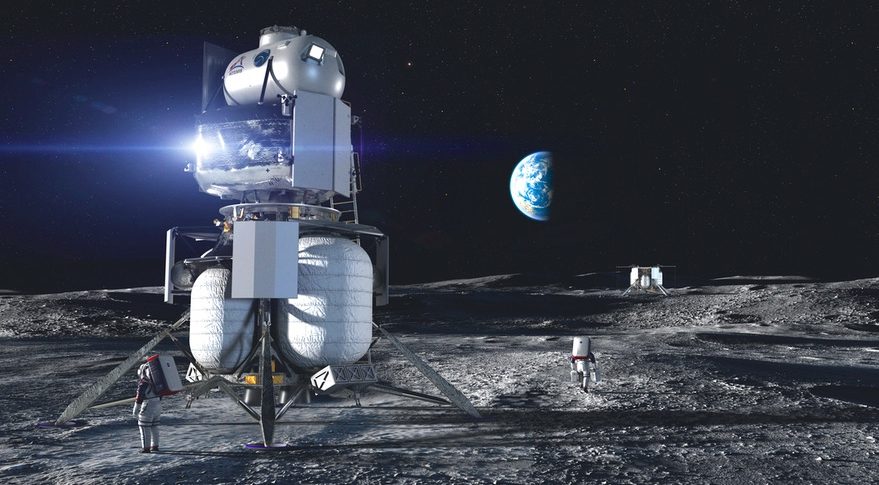In Today’s Deep Space Extra… NASA delays by three days the landing of four astronauts whose mission to the International Space Station is concluding. Hubble keeps making important astronomical observations after 31 years in orbit.
Human Space Exploration
Blue Origin protests NASA Human Landing System award
Coalition Members in the News – Boeing, Lockheed Martin, Northrop Grumman
SpaceNews.com (4/26): Blue Origin on Monday filed a protest with the Government Accountability Office (GAO) over NASA’s April 16 sole selection of SpaceX for a $2.9 billion contract to pursue further development of a lunar Human Landing System (HLS) for the first mission to return astronauts to the surface of the Moon under the Artemis program. In all, three commercial endeavors, including teams led by Blue Origin and Dynetics, had been competing for about a year. In 2020, congressional appropriators issued less funds than NASA requested to pursue the development of Human Landing Systems, a factor in NASA’s SpaceX selection, according to the agency. Dynetics also filed a protest over the contract (from an Aviation Week article under a paywall).
Return of SpaceX crew capsule delayed by high winds
Spaceflightnow.com (4/26): There will be a three-day delay in the return of the four Crew-1 Dragon astronauts from this Wednesday to Saturday due to predicted high winds in the landing zones off the Florida coast. Astronauts Mike Hopkins, Victor Glover and Shannon Walker, all of NASA, and Japan’s Soichi Noguchi are now set to undock from the International Space Station (ISS) on Friday at 5:55 p.m. EDT, with a splashdown on Saturday in the Gulf of Mexico off the coast of Panama City, Florida, at 11:36 a.m. EDT. Managers will continue to monitor the weather conditions.
Space Science
Breathtaking new Hubble image shows a giant star on the brink of annihilation
ScienceAlert.com (4/27): In celebration of the 31st anniversary of the launching of NASA’s Hubble Space Telescope, astronomers aimed the observatory at a brilliant “celebrity star,” one of the brightest seen in the Milky Way, surrounded by a glowing halo of gas and dust. The monster star’s opulence is a result of “living on the edge.” The star, called AG Carinae, is waging a tug-of-war between gravity and radiation to avoid self-destruction. The Hubble Space Telescope launched on April 24, 1990 and is still operational.
Stars made of antimatter could lurk in the Milky Way
Science News (4/26): A study of a decade of observations using the Fermi Gamma-ray Space Telescope suggests the possible presence of stars made of antimatter. The study revealed gamma rays coming from 14 sources of possible antistars in the Milky Way galaxy.
Opinion
A message of continuity from NASA’s next administrator
The Space Review (4/26): The significant takeaway from last week’s Senate Commerce Committee hearing with former U.S. Sen. Bill Nelson, President Biden’s nominee to serve as NASA Administrator, was Nelson’s belief that NASA’s mission deserves bipartisan support built around a constancy of purpose. The hearing seemed to suggest Nelson’s nomination will sail through the Senate with support for the major programs he inherits and for plans to return to the Moon with astronauts and establish a sustained presence to prepare for expeditions to Mars.
Other News
Delta IV Heavy launches classified NRO payload from California
Coalition Members in the News – Aerojet Rocketdyne, United Launch Alliance
Spaceflightinsider.com (4/26): The Delta IV rocket carrying a classified National Reconnaissance Office (NRO) satellite lifted off from Vandenberg Air Force Base, California, on Monday at 4:47 p.m. EDT. Only three Delta IVs remain in the United Launch Alliance (ULA) inventory, all of the heavy configuration.
Space Force sees need for civilian agency to manage congestion
SpaceNews.com (4/26): In an interview with SpaceNews.com, Gen. David Thompson, vice chief of space operations for the U.S. Space Force, expressed support for a civilian agency in charge of managing space traffic and regulating unsafe activities. This should include efforts to avoid collision, guidelines for satellite maneuvers and disposing of satellites that have exceeded their operational lifetimes, he noted, adding that while congestion is not yet so critical that it is impacting launch windows available, it can become a problem in the future.
China launches robot prototype capable of catching space debris with net
Reuters (4/27): Shenzhen-based Origin Space launched a technology satellite from China atop a Long March 6 rocket on Tuesday with technology demonstration payloads, including those that could pave the way toward future asteroid mining. One of the payloads, NEO-01, is designed to deploy a net to gather up, then burn space debris using electric propulsion.

